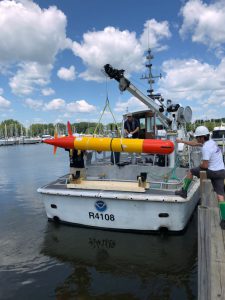Two underwater robots will be gliding throughout western Lake Erie this week, as NOAA and its partners at the Monterey Bay Aquarium Research Institute (MBARI) test technology to autonomously monitor and measure the toxicity of harmful algal blooms in the Great Lakes.

The robots — known as long-range autonomous underwater vehicles (LRAUVs) — will be deployed in western Lake Erie through August 26. During that time, one robot will map the extent and intensity of the bloom. The other robot will carry a 3rd generation (3G) Environmental Sample Processor (ESP) — known as NOAA’s “lab in a can” — to measure levels of microcystin, a potent liver toxin produced by the cyanobacteria that cause harmful algal blooms in the Great Lakes, in addition to archiving samples for later genomic analysis. The activities of the two robots will be coordinated throughout the tests. Part of the toxin-detecting robot’s course is pre-programmed to visit particular sites that are routinely sampled by NOAA scientists, while the remainder of the mission will be used to demonstrate its ability to target areas of elevated algal biomass based on data collected by the first LRAUV.
The goal of the mission is to see how the underwater vehicles perform in the field and determine what tweaks are required to transition them into a permanent part of NOAA’s efforts to forecast, monitor, and understand harmful algal blooms in the Great Lakes. This is NOAA’s second year testing the LRAUVs, and the first year that two vehicles have gone out simultaneously. The two vehicles will be accompanied by an airplane that will be flying below the clouds, taking hyperspectral images of the bloom and mapping it from the sky. These images provide a three-dimensional view of what the bloom looks like on and below the water’s surface. NCCOS will use these tests to optimize performance of the onboard microcystin sensor it has developed in collaboration with its partners to provide reliable, accurate assessments of bloom toxicity.

Continuous monitoring of harmful algal blooms is important, because blooms — which develop when excess nutrients from fertilizers, sewers, and water treatment plants are washed into the Great Lakes, causing algae to grow out of control — can contaminate drinking water and pose a risk to people and animals that come in contact with the lakes. Information gleaned from genomic analysis of samples archived during the mission will yield important insights on bloom biology and ecology that will improve toxicity forecasts being developed by NOAA and its partners.
Partners on the project include the NOAA Great Lakes Environmental Research Laboratory (GLERL), the Cooperative Institute for Great Lakes Research (CIGLR), and the Monterey Bay Aquarium Research Institute (MBARI). For more details on this mission, see the NOAA Research news story.

